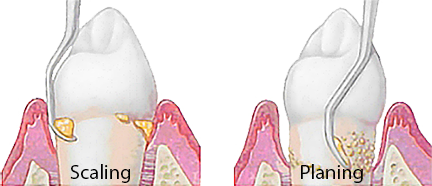What is Root Planing and Scaling?
 The American Dental Association specialty organization, the AmericanAcademy of Periodontology (AAP) has treatment guidelines stating that periodontal health should be achieved in the least invasive and most cost-effective manner. This is often accomplished through non-surgical periodontal treatment, including root planing and scaling (a careful cleaning of the root surfaces to remove plaque and calculus (tartar) from deep periodontal pockets and to smooth the tooth root to remove bacterial toxins), with adjunctive therapy such as local delivery antimicrobials, systemic antibiotics as needed on a case by case basis, depending on the severity of the disease. A dental professional, like a Periodontist that regularly studies the extensive periodontal literature can help you separate fact from hype and has the skills and techniques to perform these tasks.
The American Dental Association specialty organization, the AmericanAcademy of Periodontology (AAP) has treatment guidelines stating that periodontal health should be achieved in the least invasive and most cost-effective manner. This is often accomplished through non-surgical periodontal treatment, including root planing and scaling (a careful cleaning of the root surfaces to remove plaque and calculus (tartar) from deep periodontal pockets and to smooth the tooth root to remove bacterial toxins), with adjunctive therapy such as local delivery antimicrobials, systemic antibiotics as needed on a case by case basis, depending on the severity of the disease. A dental professional, like a Periodontist that regularly studies the extensive periodontal literature can help you separate fact from hype and has the skills and techniques to perform these tasks.
Scaling is the process by which dentists and hygienists remove bacterial plaque (Biofilms), calculus, stains, food debris and other accretions from the surfaces of the tooth. Root planing is a separate procedure that can be performed at the same time as scaling but is best performed at separate appointments from the initial scaling during multiple visits of periodontal therapy. Root planing is a definitive treatment procedure designed to remove cementum or surface dentin that is rough, impregnated with calculus, or contaminated with toxins or microorganisms. Root Planing is the process by which residual embedded calculus and disease root cementum are removed from the tooth surface to produce a smooth, hard and biologically clean surface which helps allow patient's oral tissues namely, the periodontal (gum) tissues, and supporting bone to repair, regenerate on the tooth root surfaces of the dentition. Root planing requires refined sharp smooth dental instruments made specifically for the procedure to create as close as possible a root surface smoothness once again, similar to the white enamel of a tooth, or a kitchen glass or other smooth surface that will minimize bacterial growth and help prevent repopulations of microorganisms on the root. The root surfaces during and after root planing should be tested for smoothness with special instruments.
For most patients of advanced periodontal disease, those having periodontal disease pocket depths of 5mm to 10mm or more, the favorable reduction in disease parameters will occur when root planing and scaling is performed repeatedly for each tooth for each of the 4-6 visits over 3-5 months. Research indicates significant periodontal health improvements with recordings of bacterial scores, bleeding on pocket probing, probing pocket depths and probing attachment levels following 3-5 months after start of therapy. Many patients have little to no discomfort when they have root planing and scaling done by experienced periodontal clinicians and require no anesthetics for pain or discomfort. As a contracted dental insurance company provider, the fees for covered periodontal services including these comprehensive services of root planing and scaling at my office, are established and they are usual and customary. Research indicates, however, that when pocket depths at some teeth persist despite this above approach to restore health, then periodontal surgery is indicated to visibly ensure that root planing is thoroughly performed to allow for pocket probing depths to return to the 1-3mm normal range and complete this root planing treatment task properly.